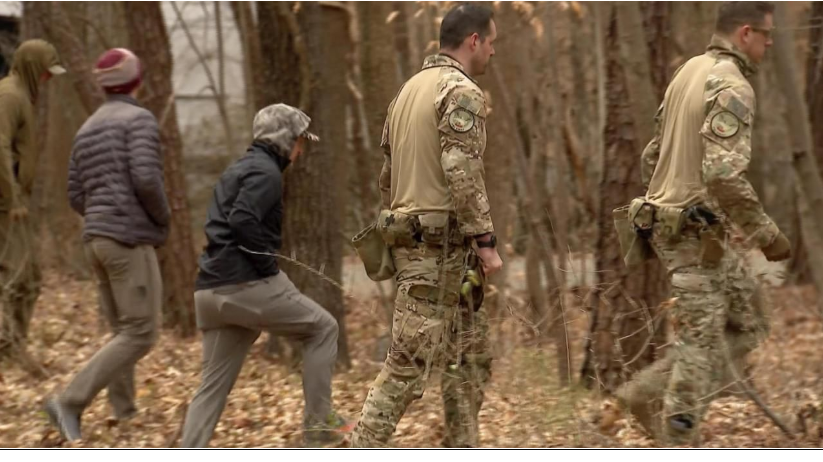
Our investigative post reveals a disturbing case where brilliant minds turned to brutal violence. Following months of investigation, Jack Lasota, 34, the alleged leader of the Zizians – a group of highly intelligent computer scientists in their 20s and 30s – has been arrested in Maryland. The arrest comes after the group’s connection to at least six murders across Vermont, Pennsylvania, and California, including the killing of U.S. Border Patrol Agent David Maland. As our investigative post reporters uncovered, these young tech professionals, who initially met online, shared anarchist beliefs that eventually led to a string of violent crimes. The group’s activities gained national attention following the January 20, 2025 shooting of Agent Maland, 44, during a routine traffic stop in Coventry, Vermont. Their sophisticated background and sudden turn to violence has raised serious concerns about the dangers of online radicalization.

FBI Captures Zizian Leader in Multi-State Raid
Maryland State Police captured Jack LaSota, 34, the alleged Zizian leader, in a coordinated raid on February 16 . The arrest occurred alongside Michelle Zajko, 33, from Media, Pennsylvania, marking a significant breakthrough in the multi-state investigation .
Maryland arrest details
State authorities charged both suspects with multiple offenses, specifically trespassing, obstructing law enforcement, and possession of a handgun in their vehicle . A bail hearing was scheduled for 11 a.m. Tuesday at Allegany District Court . Before this arrest, LaSota had missed court appearances in two states, subsequently leading to multiple bench warrants.
Weapons seized
The FBI’s search revealed an arsenal of sophisticated equipment:
Ballistic helmet and night-vision goggles
Respirators and ammunition
Two-way radios
Used shooting range targets
Coordinated operation timeline
The investigation intensified when FBI agents conducted a court-authorized search of a wooded area near Chapel Hill. According to local resident Candice Welch, the operation involved significant federal presence: “Woke me up out of my sleep. It was a real loud bang, about 30 minutes apart” [1].The landlord of the Chapel Hill property confirmed that LaSota, along with Teresa Youngblut and Felix Bauckholt, had been residing there earlier in winter. Additionally, the FBI’s investigation revealed LaSota’s involvement through digital surveillance and forensic evidence linking the group to multiple crime scenes .
The investigative post reporters uncovered that LaSota, who uses she/her pronouns and identifies as a transgender woman, had previously expressed hostility toward rationalist groups operating in online spaces . Moreover, her attorney Daniel McGarrigle has declined to comment on any potential connections to the series of deaths under investigation.
How Did Border Agent’s Murder Expose Tech Cult?
The fatal shooting of Border Patrol Agent David Maland unraveled a complex web of violence linked to the Zizian group. The incident, which occurred in Coventry, Vermont, about 20 miles from the Canadian border , marked a turning point in exposing the group’s activities.
Vermont shooting breakdown
The sequence of events began on January 14, when Teresa Youngblut and Felix Bauckholt checked into a Vermont hotel . A vigilant hotel worker’s report about suspicious behavior and weapons prompted authorities to place the pair under surveillance .Consequently, on January 20, Border Patrol agents intercepted their vehicle on Interstate 91 .
The traffic stop quickly escalated into a deadly confrontation. Youngblut, who was driving, opened fire on the officers . In the ensuing shootout, both Agent Maland, 44, and Bauckholt, who also went by the name Ophelia, lost their lives . Meanwhile, Youngblut sustained injuries and was subsequently arrested [1].
Digital surveillance revelations
Our investigative post reporters uncovered that the shooting investigation led authorities to a broader network of criminal activities. The weapon used in the Vermont incident was traced to a person of interest in the December 31, 2022, murders of Richard and Rita Zajko in Pennsylvania.
Furthermore, a search of the suspects’ vehicle revealed an arsenal of sophisticated equipment:
Night-vision goggles and ballistic helmet
Respirators and ammunition stocks
Two-way radio communication devices
Used shooting range targets
The digital trail intensified when investigators discovered frequent communications between Youngblut and several other suspects.Nevertheless, the most significant breakthrough came through Youngblut’s connection to Snyder, with whom she had applied for a marriage license . This relationship provided investigators with crucial links to other homicides across state lines.
The investigation revealed that both Youngblut and Bauckholt had been residing in North Carolina condominiums, where neighbors reported observing unusual behavior . These digital and physical surveillance findings ultimately helped authorities establish connections between six separate murder cases spanning Vermont, Pennsylvania, and California .
Tech Geniuses Turn to Violence
Behind the violent facade of the Zizian group lies a network of highly educated tech professionals. The investigative post reporters discovered a disturbing pattern of how these individuals channeled their technical expertise into increasingly dangerous activities.
Computer science backgrounds
Jack LaSota’s journey from academic excellence to extremism began after earning a computer science degree from the University of Alaska Fairbanks in 2013 . Rather than pursuing a traditional career path after completing an internship at NASA, LaSota moved to the San Francisco Bay area . Notably, most group members shared similar educational backgrounds, primarily in their 20s and 30s with advanced computer science degrees .
Online radicalization patterns
The group’s descent into violence followed a calculated trajectory. Although initially connected through online platforms, these
tech professionals ultimately formed a tight-knit network sharing anarchist beliefs [1]. LaSota, who uses she/her pronouns, began
publishing concerning content under the name “Ziz,” particularly focusing on theories about brain hemispheres harboring separate values and “desires to kill each other”.
The radicalization process intensified as LaSota targeted “extremely vulnerable and isolated” followers [1]. Particularly concerning
was the group’s manipulation of online spaces to spread their ideology. Their technical sophistication enabled them to exploit
various platforms, including:
Social media networks
Mobile applications
Online gaming platforms
Encrypted communication channels [2]
Cryptocurrency transactions traced
The group’s technical prowess extended to their financial operations. Despite their sophisticated use of technology, investigatorssuccessfully traced cryptocurrency transactions linking members to various criminal activities [1]. Nonetheless, the group
demonstrated advanced capabilities in using emerging technologies, hence raising serious concerns among law enforcement
agencies [1].
The investigative post uncovered that the group’s technical sophistication posed unique challenges for law enforcement. Their
expertise in artificial intelligence, biotechnology, and cryptocurrency created a complex web of digital activities [1]. Ultimately, this
combination of technical knowledge and extremist ideology proved particularly dangerous, as the group utilized their skills to
evade detection while planning violent acts.
The radicalization pattern showed striking similarities to other online extremist movements, primarily exploiting social media
algorithms to spread their message [1]. The group’s activities demonstrated how quickly extremist content could move from fringe
platforms to mainstream channels, creating what experts describe as an “attack on the supply chain of information” [3].
Investigators Connect Six Murder Cases
Digital forensics experts pieced together a complex web of evidence linking six murders across Vermont, Pennsylvania, and
California. The investigative post reporters uncovered how advanced technological analysis became crucial in connecting these
seemingly isolated incidents.
Evidence timeline
A series of violent events unfolded starting with Curtis Lind’s attack in November 2022, where he was impaled with a samurai
sword in Vallejo, California [1]. Thereafter, on December 31, 2022, Rita and Richard Zajko were found dead from gunshot wounds
to the head in their Chester Heights home [1].
The pattern continued into 2023, primarily focusing on the January shooting that claimed Agent David Maland’s life during a
routine traffic stop [1]. Simultaneously, investigators discovered connections to Curtis Lind’s murder that same month, as he was
killed by a masked figure wielding a knife [1].
Digital forensics breakthrough
The breakthrough in connecting these cases came through sophisticated digital analysis techniques. Investigators utilized multiple
forensic tools:
Location data reconstruction to track suspect movements
Search history analysis revealing behavioral patterns
Timeline reconstruction through device data
Digital footprint analysis across multiple platforms [2]
The forensic team’s examination of search histories proved instrumental in establishing premeditation and intent [2]. Ultimately,
this digital evidence allowed investigators to reconstruct detailed timelines of suspect activities, combining location data with
communication logs [2].
The investigative post uncovered that cryptocurrency transactions provided additional links between group members. Law
enforcement officials traced digital financial trails that connected various suspects to crime scenes [3]. Afterward, investigators
combined this evidence with surveillance footage, particularly from the Newport City Inn, which captured crucial moments leading
up to several incidents [3].
The forensic breakthrough occurred when experts applied next-generation sequencing to analyze mixed DNA samples from
complex crime scenes [1]. This technical advancement, coupled with centralized digital databases, enabled rapid comparison of
DNA profiles across jurisdictions [1]. The Combined DNA Index System (CODIS) undeniably accelerated the process of linking
evidence from multiple crime scenes [1].
What Makes Zizians Different from Other Cults?
Unlike traditional cults, the Zizians represent a new breed of technologically sophisticated extremists. The investigative post
reporters discovered that their distinct characteristics stem from a complex blend of artificial intelligence philosophy, technical
prowess, and targeted recruitment strategies.
AI philosophy
The group’s core beliefs center around artificial intelligence and its potential impact on humanity. LaSota, writing under the name
Ziz, developed an unusual theory about brain hemispheres holding separate values and genders that “often desire to kill each
other” [3]. Indeed, she shared rationalists’ belief that artificial intelligence would soon attain godlike power and could potentially
destroy humanity if not properly controlled [2].
Primarily, the group’s ideology differed from conventional cults through its fusion of AI concerns with radical veganism. LaSota
believed that society consisted of “flesh-eating monsters” and insisted that any future super-AI must benefit animals too [2]. This
philosophical stance set them apart from other tech-focused groups, as they combined advanced technological concepts with
extreme ethical positions.
Technological sophistication
The group’s technical capabilities surpassed those of traditional cult organizations. Given these points, their members’
backgrounds in computer science and data science created a foundation for sophisticated operations. As opposed to conventional
cult practices, the Zizians utilized:Advanced encryption methods for communication
Cryptocurrency for financial transactions
Digital surveillance countermeasures
Sophisticated online presence management
Their technical expertise essentially transformed how they operated, with members wrapping phones in aluminum foil and utilizing
night vision devices [4]. This level of technological awareness made them particularly challenging for law enforcement to track.
Recruitment methods
The Zizians’ recruitment approach focused specifically on marginalized individuals within online communities. Professor Poulomi
Saha, who studies cult behavior, noted that LaSota’s writings resonated with readers who felt unseen, making them particularly
vulnerable to recruitment [1].
The group’s recruitment strategy proved especially effective in digital spaces where isolated individuals sought connection.
Analogous to other online movements, they targeted:
Members of the rationalist community
Individuals interested in AI ethics
People exploring gender identity
Those involved in radical veganism
Jessica Taylor, an AI researcher familiar with LaSota, observed that the group used rationalist ideology as justification for their
actions [1]. The investigative post uncovered that this combination of intellectual appeal and emotional manipulation made their
recruitment particularly effective among well-educated, technically skilled individuals.
The group maintained a decentralized structure, with one member stating, “There’s no organization. There’s no centralization.
We’re just a bunch of anarchist trans leftists trying to exist” [2]. This loose structure, ultimately, made it more difficult for
authorities to identify and track members compared to traditional hierarchical cults.
Conclusion
The arrest of Jack LaSota marks a significant turning point in dismantling one of America’s most technologically sophisticated
extremist groups. Law enforcement agencies faced unprecedented challenges while tracking the Zizians, who combined advanced
technical knowledge with dangerous ideological beliefs. Their connection to six murders across three states demonstrated how
digital expertise could enable cross-border violence.
Above all, the Zizian case highlights dangerous intersections between technological prowess and extremist ideologies. The group’s
members, primarily computer scientists in their 20s and 30s, used their skills to orchestrate complex operations while maintaining
digital anonymity. Meanwhile, their sophisticated recruitment methods targeted vulnerable individuals within online communities,
proving particularly effective among well-educated tech professionals.
The investigation’s success ultimately relied on cutting-edge digital forensics, allowing authorities to piece together evidence from
multiple crime scenes. Consequently, this case serves as a wake-up call about evolving threats in our digital age. Law enforcement
agencies must now adapt their strategies to combat technically sophisticated groups that exploit online spaces for radicalization
and violence.






